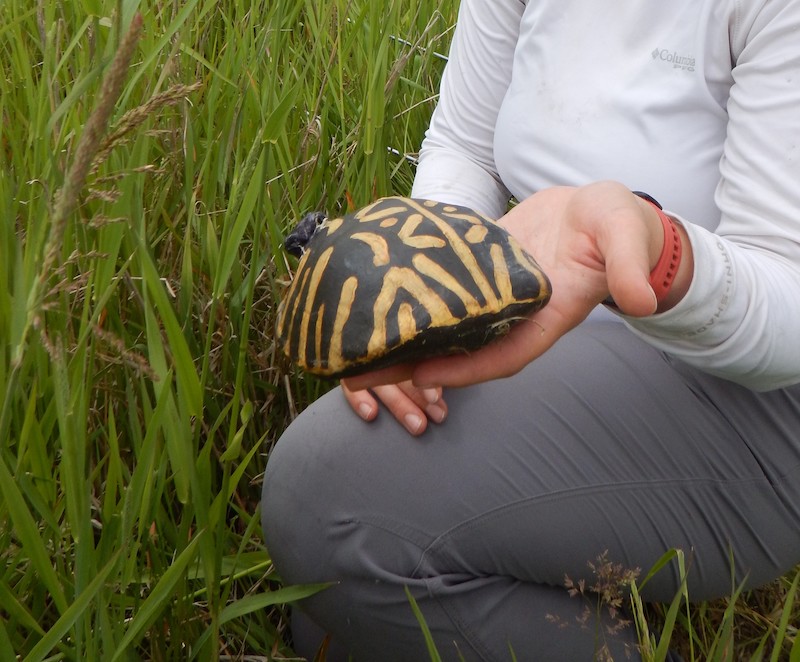
Located within its grassy habitat, this ornate box turtle, donning a data logger and radio transmitter, will have served to advance knowledge about its habitat needs.



Located within its grassy habitat, this ornate box turtle, donning a data logger and radio transmitter, will have served to advance knowledge about its habitat needs.
Photos by the author.

“What’s it take to be a turtle?” That is the question on the mind of a certain herpetologist, Andrea Colton, an University of Illinois graduate student, affiliated with the Prairie Research Institute. The turtle which Colton decided to investigate is the ornate box turtle. However, since the ornate box turtle is listed as threatened in Illinois, permission to conduct research was required. On Colton’s behalf, Mike Dreslik, a scientist with the Prairie Research Institute of the Illinois Natural History Survey, filed the request to conduct research at natural areas owned by the State and The Nature Conservancy where populations of the turtles (albeit, small populations) had been documented. Permission was granted under the State Parks Act and the Illinois Administrative Code, with certain terms enumerated.
Colton would be transversing acres of grassland habitat while attempting to locate ornate box turtles. Protocol required decontamination procedures intended to deactivate any pathogens and thereby to prevent the spread of disease. So, before entering a natural area, Colton first worked to remove all soil and debris from her personal gear, such as clothing and boots, and from her research equipment. She either dipped or sprayed items with a 10 percent solution of household bleach. Decontamination could include air drying and storage for at least two weeks but only if the pieces of equipment could not withstand the bleach treatment and were deemed free of residues. During research within a natural area, Colton would limit contact with the turtles and would sanitize her hands if touch was unavoidable.

Also, before each trip to a natural area, Colton would examine gear and remove any plant material she found, just in case, for example, a seed had become lodged within the tread of her boots or a seam of her pants. Thus, her actions met the specification that all equipment and work clothing be clean and free of any seeds/mud for the purpose of preventing the spread of exotic or invasive plants/plant propagules. Disturbance of sensitive areas within the natural areas was disallowed, and so Colton would obtain directives from site superintendents before each day of field work.
Colton wished to determine a turtle’s resting metabolic rate as affected by temperature and body mass. To discover what ambient temperatures the turtle might encounter while doing what a turtle does within its preferred habitat, she utilized a turtle shell model upon which a temperature recording device or data logger was attached. Each model was placed in locations selected for their varying percentages of vegetative cover (ranging from sparsely vegetated, 0 – 15 percent, to densely vegetated, 85 -100 percent). Temperature data from each model, combined with data about the metabolic rate of the live turtles, would serve to determine how much energy the ornate box turtle would need to expend while simply existing at varied temperatures within its habitat of varied vegetative cover.

Because radio transmitters had been previously attached to the turtles’ shells, Colton could use the tracking antennae and radio receiver to locate the turtles within each natural area. She attached data loggers to the turtles’ shells. During the months of her study period, she made multiple trips to each natural area to ascertain the turtles’ movements. She recorded GPS readings. To recognize individual turtles, Colton noted the pattern or series of indentations or notches at the edge of each one’s carapace. Those notches were the result of a marking procedure applied during prior studies. In the early 2000s, ornate box turtles were captured and marked, and radio transmitting devices were glued to each turtle’s carapace. Subsequent surveys helped to develop estimates of survival and fecundity at sentinel sites in northern, mid and southern Illinois.
Since Colton needed to utilize environmental chambers and equipment located in the Population and Community Ecology Laboratory on the University of Illinois’ campus, she did remove a limited number of turtles from their habitat temporarily. In the laboratory, each turtle went through a time of fasting and then occupied a chamber in which the temperatures were regulated, ranging from 15°C to 30°C. During a 12-hour period, a turtle would reside periodically within the chamber. Gases within the air available for the turtle within the chamber were analyzed. Variations in the amounts of those gases (oxygen, water vapor and carbon dioxide) over the period of the turtle’s occupation were analyzed. Since carbon dioxide is released during respiration, variations in quantities of carbon dioxide would be indicative of metabolic rate, thus quantifying how much energy the turtle was expending. Colton hypothesized that higher temperatures would increase the turtle’s metabolic rate. Consistently she observed levels of carbon dioxide incrementally rising as temperatures rose. She also noted that a turtle’s body mass influenced volume of carbon dioxide.

Since turtles are poikilothermic animals, they are affected greatly by the temperatures within their habitats. A turtle may adjust its behavior in response to ambient temperatures to maintain optimal metabolic rates. For example, if high temperatures threaten an ornate box turtle’s well-being, it may move to an underground situation, especially when vegetative cover offers insufficient shade. The turtle may then go through a period of brumation. In so doing, the turtle may miss an opportunity to find a mate; thus, reproductive success could be reduced.
At the end of her research period, which stretched from March to October, Colton removed the data loggers which had been attached to the shell models and the live turtles’ shells. This winter as she works to analyze data and form conclusions, she will download temperature recordings from the data loggers. Colton foresees the data revealing temperature fluctuations with higher temperatures corresponding to lower percentages of vegetative cover. From the data gathered in the laboratory, she will calculate an ornate box turtle’s typical energy budget during summertime ranges of temperature.
Colton’s research will augment the works of other researchers who are collaborating with the Illinois Department of Natural Resources through the Illinois State Wildlife Grant Program to complete studies which can be used for recovery and conservation applications. Land stewards will have access to knowledge about managing grasslands as suitable habitat for ornate box turtles and other species.
For years, Patty Gillespie shared her enthusiasm for language and nature and got paid for it at a public school and at a nature center. Now she plays outdoors as often as she can and writes for the sheer joy of it.
Submit a question for the author